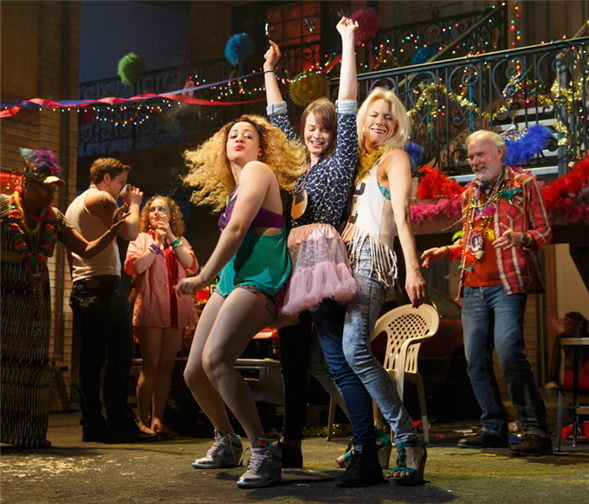Lisa D'Amour on the torrent of words in her play Airline Highway
---
There are so many words tumbling around in
Airline Highway, so many sly asides and sassy jokes delivered under the breath, that it might seem the conversation in the play is just
happening, as though playwright Lisa D'Amour told her actors to chat with each other about whatever came to mind.
But that's not true, of course. D'Amour has carefully structured the show, which follows a single day at a run-down New Orleans motel called the Hummingbird. The vast community of long-term residents – which includes junkies, strippers, drag queens, and at least one aspiring poet – is preparing a funeral party for Miss Ruby, the former showgirl who has become their matriarch. Miss Ruby is dying in an upstairs room, but since she wanted to attend her own funeral before kicking the bucket, folks are hanging streamers and making sandwiches while there's still time.
Their constant chatter is calibrated to teach us things about their world, which is currently on Broadway at Manhattan Theatre Club's Samuel J. Friedman Theatre. If we listen carefully, we can learn not only about the individual hearts of the 16-plus characters, but also about the strange and vibrant culture they've created in the motel parking lot.
For D'Amour, the rush of language is partly meant to evoke her native city. "In New Orleans when people start talking, you just have to let them talk," she says. "They're not gonna shut up. They are not. So it was fairly easy for me to let people [in the play] talk. And I was very interested in the way people talk over each other and take focus."
But it's not just the volume of words that's important. It matters that D'Amour lets us hear from so many different kinds of people. Though they've all ended up at the Hummingbird, the characters represent a wide swath of economic and ethnic backgrounds, and they range from teenagers to senior citizens.
That points to a larger thematic purpose. "My day in New Orleans is filled with talking to people of a lot of different walks of life," says D'Amour. "I live a very multi-generational, multi-class life when I'm there, and it was important to me to let all those people speak."
{Image1}
As the play has developed, in fact, she has advocated to retain monologues for some of the supporting players that might normally be cut. (She wrote the piece for Chicago's Steppenwolf Theatre Company, where it premiered it last December. Many of the original cast members have traveled to Broadway.)
"I see [keeping those monologues] as getting a sudden window into each character's life," D'Amour says. "The play gains a sense of the vastness of humanity – that inside every person is this unfathomable wealth of stories and histories and conflicting desires. I think you feel that bursting from the seams of this play."
And if we get a sense of that vastness, then we also have to accept the inherent worth of this community. D'Amour hopes audiences savor its oddness and sharp edges, particularly in an age when chain-store living tends to obscure our individuality.
"There's something about the play – and this is beyond it being set in New Orleans – that I hope makes people want to drop assumptions and explore a little bit," she says. "We're so slammed by marketing of all sorts about the way our lives should look. There's this feeling in the play of, 'Oh my God, the generic Costco is going up across the street from the Hummingbird. And we
are dysfunctional, but is that
more functional?'"
She continues, "When we buy into, 'Oh, I'm just gonna buy this food 'cause it's quick, buy these clothes 'cause it's quick, go on this career path because it's known,' we threaten our ability to be unique. We start to forget that we can invent ourselves [and] that we can have feelings we don't understand."
Inside all the talk at the Hummingbird, then, is a struggle to maintain an identity – to observe and honor and perpetuate a way of life that has embraced people who don't belong anywhere else.
"The fact that they are not cut to any particular pattern is really obvious," D'Amour says. Then she adds a coda that makes the Hummingbird big enough for everyone: "I think that's true for all of us. Nobody's cut from a particular pattern, even if we bought our whole outfit at the Gap. So I think there's something in the play that's not just about other people. It's about ourselves."
---
Mark Blankenship is the editor-in-chief of TDF Stages
Photos by Joan Marcus
